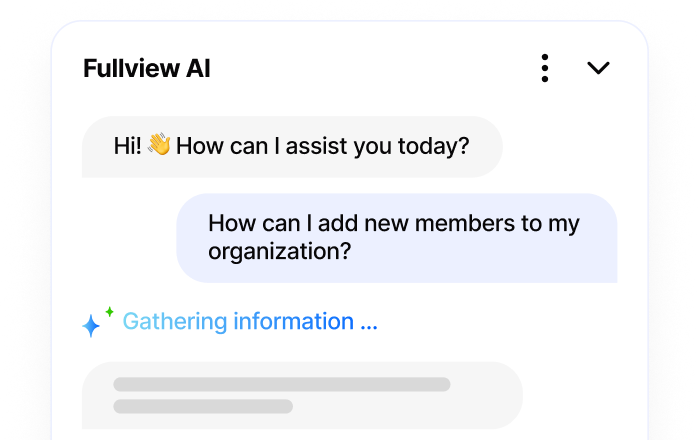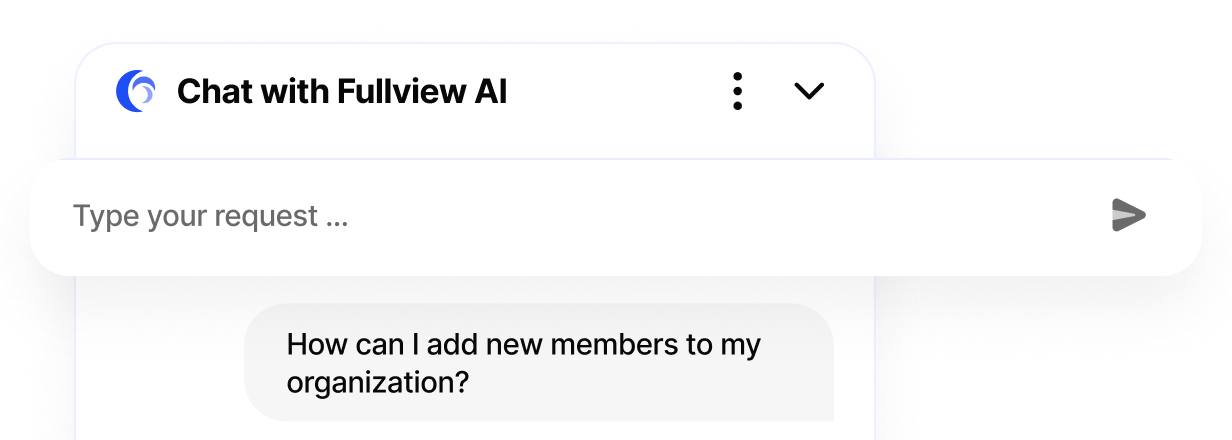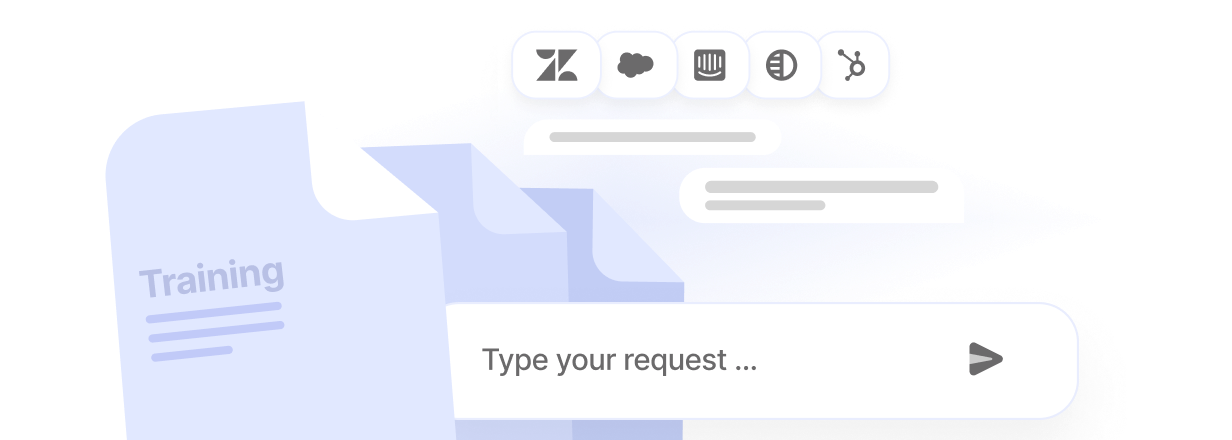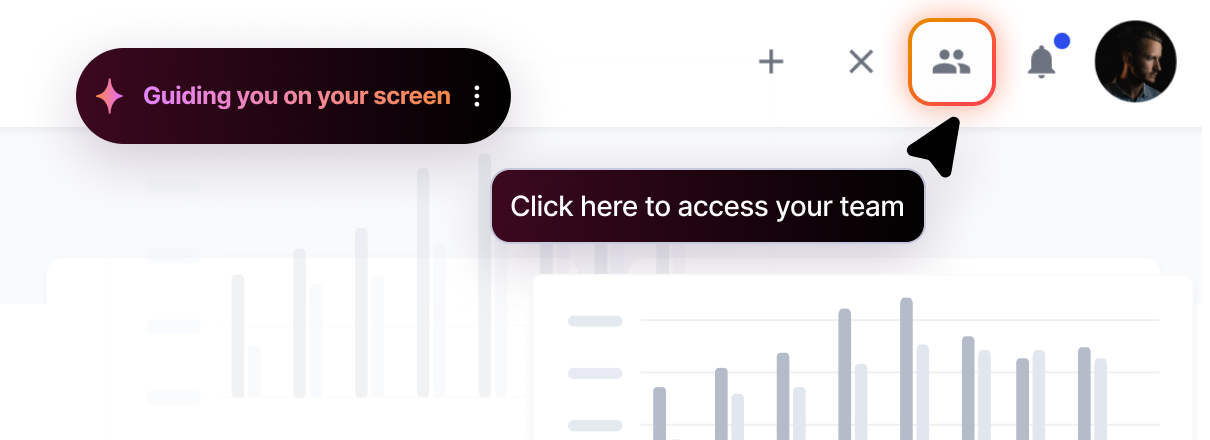First impressions can make or break your business relationships. In fact, if you provide good onboarding, you retain 86% of customers after the first month. But here's the reality: only 12% of employees agree their organization has a good onboarding process.
The customer onboarding software market has evolved dramatically in 2025. We've moved beyond simple email sequences and basic tutorials to AI-powered platforms that can visually guide users through complex workflows, take actions on their behalf, and provide real-time support that feels genuinely helpful.
Bottom line: The best customer onboarding software in 2025 doesn't just automate your process—it creates experiences that make customers and employees actually want to stick around.
What's Actually Changed in Customer Onboarding Software
Traditional onboarding meant sending welcome emails, sharing knowledge base articles, and hoping for the best. Today's leading solutions use visual AI to see what users see, guide them step-by-step through your actual product, and even complete tasks for them when needed.
The shift is fundamental: from reactive support to proactive guidance. Instead of waiting for users to get stuck and submit tickets, modern onboarding software intervenes in real-time to prevent problems before they happen.
This isn't just about SaaS companies anymore. Financial services need identity verification, small businesses want automated workflows, and enterprises require compliance tracking. The market has segmented into specialized solutions that solve specific onboarding challenges.
What is Customer Onboarding Software?
Customer onboarding software helps businesses streamline the process of bringing new clients, customers, or employees into their ecosystem. Think of it as your ultimate onboarding assistant—automating repetitive tasks, providing guided experiences, and ensuring every new user feels supported from day one.
These tools go far beyond simple welcome emails. Modern onboarding software can:
- Automate document collection and verification
- Provide interactive product tours and training
- Track progress through each onboarding step
- Integrate with your existing business systems
- Offer real-time support when users get stuck
- Ensure compliance with industry regulations
The goal is simple: get new users to their "aha moment" as quickly as possible while reducing the burden on your team.
Benefits of Customer Onboarding Software
Understanding the real impact helps justify the investment and set proper expectations:
Accelerated Time-to-Value
Good onboarding software helps new users experience your product's value immediately rather than struggling through setup. This means faster adoption, higher satisfaction, and reduced early churn.
Massive Efficiency Gains
By automating routine tasks like data entry, document collection, and initial training, these tools free up your team to focus on strategic relationship building rather than administrative work.
Improved Retention Rates
The numbers don't lie: companies with strong onboarding processes see 86% customer retention after the first month. Poor onboarding is often the difference between long-term customers and early churn.
Consistent Experience
Software ensures every user gets the same high-quality onboarding experience, regardless of which team member they interact with or when they sign up.
Better Data and Insights
Modern platforms track every step of the onboarding journey, showing you exactly where users get stuck and what improvements drive the biggest impact.
ROI Reality Check: Companies typically see 150-400% ROI from proper onboarding software implementation, with payback periods of 6-12 months.
Best Customer Onboarding Software by Category
The market has evolved into distinct categories serving different onboarding needs. Here's what actually works in 2025:
AI Onboarding Agents

Fullview Innovative onboarding solution that takes a different approach from traditional tools. Instead of generic tutorials, Fullview's AI provides personalized, visual guidance that adapts to each user's specific context and needs.
Key capabilities:
- AI-powered visual guidance: Shows users exactly how to complete tasks, right on their screen
- Autonomous problem-solving: Can complete complex workflows like account setup or feature configuration
- Real-time contextual support: Uses session replays and error logs to understand user experiences
- Seamless escalation: Provides full context when human agents need to take over
- Zero-download cobrowsing: Instant screen sharing and control without software installation
Perfect for: SaaS companies, fintech, healthcare, or any business where onboarding involves navigating complex workflows.
Companies using Fullview typically see 40% reduction in onboarding times and 27% decrease in early churn. The platform integrates seamlessly with existing helpdesk systems like Intercom, Zendesk, and Salesforce Service Cloud.
Want to see visual AI onboarding in action? Book a demo to see how AI can guide your customers through complex workflows.
Traditional SaaS Onboarding Tools
Appcues No-code platform for creating in-app onboarding flows with A/B testing capabilities. Great for standard SaaS onboarding but limited to pre-built tour functionality.
Best for: SaaS companies that want to improve basic user experience with standard onboarding flows.
Userpilot Behavior-triggered onboarding experiences that adapt based on user interactions. Solid analytics but requires significant setup time.
Best for: Product-led growth companies that want to create segmented user journeys.
Pendo Product analytics combined with in-app guidance. Strong on data collection but the onboarding features feel secondary to analytics.
Best for: Companies that need both product analytics and basic onboarding in one platform.
WalkMe Interactive step-by-step guides for complex software processes. Reliable but feels dated compared to AI-powered alternatives.
Best for: Enterprise software with complex multi-step processes that don't change frequently.
Chameleon Targeted onboarding tours that react to user actions. Good customization options but limited real-time support capabilities.
Best for: Companies wanting adaptive onboarding paths that evolve based on user behavior.
Business Management & Client Onboarding
Bonsai Comprehensive business management tool with client onboarding features. Includes proposals, contracts, and automated workflows.
Best for: Freelancers and agencies that need project management alongside client onboarding.
HoneyBook Popular with creative professionals for client management and project workflows. Simple onboarding features but limited customization.
Best for: Small creative businesses, photographers, wedding planners, and similar service providers.
Dubsado User-friendly platform designed for solopreneurs with strong automation features for client communications.
Best for: Freelancers and small service businesses that want automated client onboarding workflows.
Process Street Business process management that can handle complex onboarding checklists and workflows.
Best for: Companies that need detailed process documentation and want to automate multiple business workflows.
Identity Verification & Digital Onboarding
For businesses requiring identity verification, compliance, and document authentication:
Signzy No-code platform for financial institution onboarding with AI-powered assistance and risk assessment tools.
Best for: Banks, fintech, and financial services requiring KYC/AML compliance.
Jumio Complete identity verification and authentication platform processing over a billion transactions.
Best for: High-volume businesses needing proven identity verification at scale.
Onfido User-friendly identity verification with focus on simplicity and intelligent verification methods.
Best for: Companies needing straightforward KYC compliance without complex setup.
Trulioo Global identity verification platform with local ecosystem integrations for international businesses.
Best for: Companies operating in multiple countries needing worldwide identity verification.
Industry-Specific Examples
Slack Revolutionized team communication onboarding with friendly prompts and guided interactions that make complex features feel intuitive.
HubSpot Comprehensive marketing platform with tailored tutorials that introduce features step-by-step for different user roles.
Asana Project management platform with intuitive guides covering everything from task creation to advanced project tracking.
Zoom Simplified video communication onboarding ensuring users can start hosting or joining calls immediately with minimal friction.
How to Choose the Right Onboarding Software
Start with your biggest challenge:
Complex product requiring hands-on guidance? → Visual AI platforms like Fullview that can actually show users what to do
High-volume user onboarding with basic needs? → Traditional tools like Appcues or Userpilot
Client-focused business with contracts and payments? → Business management platforms like Bonsai or HoneyBook
Financial services requiring identity verification? → Specialized platforms like Signzy or Jumio
Enterprise software with complex workflows? → Process management tools like Process Street
Integration requirements: Consider what systems need to connect. Visual AI tools typically integrate with helpdesk platforms, while business management tools connect with payment and CRM systems.
Budget reality check:
- Small business/startup: $50-200/month for basic onboarding tools
- Growing SaaS company: $200-1,000/month for comprehensive platforms
- Enterprise: $1,000-5,000+/month for advanced features and compliance
Team capabilities: Some platforms require technical setup while others offer plug-and-play solutions. Consider your team's technical expertise when evaluating options.
Implementation Guide
Phase 1: Assessment (Week 1-2)
- Map your current onboarding process and identify pain points
- Gather feedback from recent customers about their experience
- Define success metrics (time-to-value, completion rates, satisfaction scores)
- Audit your existing tech stack for integration requirements
Phase 2: Platform Selection (Week 3-4)
- Demo 3-5 platforms that match your primary use case
- Test integration capabilities with your existing systems
- Calculate total cost of ownership including implementation and training
- Get input from team members who will use the software daily
Phase 3: Setup & Integration (Week 5-8)
- Configure the platform based on your specific workflows
- Set up integrations with existing systems (CRM, helpdesk, analytics)
- Create initial onboarding content and flows
- Train your team on the new system
Phase 4: Testing & Launch (Week 9-10)
- Run pilot programs with a small group of new users
- Gather feedback and refine the process
- Launch to all new users while monitoring key metrics
- Plan regular optimization cycles based on user data
Pro tip: Start simple and add complexity gradually. It's better to have a basic system working well than a complex system that overwhelms your team.
What to Look for in Customer Onboarding Software
Must-Have Features
Customization Options: Every business has unique needs. Look for software that lets you tailor workflows, content, and branding to create personalized experiences.
User-Friendly Interface: Your team should be able to master the software quickly. Complex tools that require extensive training often create more problems than they solve.
Integration Capabilities: Seamless connection with your CRM, project management tools, payment systems, and other essential business software.
Analytics and Reporting: Track metrics like completion rates, time-to-value, and user engagement to measure effectiveness and identify improvement opportunities.
Advanced Capabilities
Real-Time Support: The ability to provide immediate assistance when users get stuck, whether through live chat, screen sharing, or AI guidance.
Automation: Streamline repetitive tasks like document collection, follow-up emails, and progress tracking.
Compliance Features: For regulated industries, ensure the platform meets requirements for data protection, audit trails, and regulatory reporting.
Mobile Optimization: Many users will access onboarding materials on mobile devices, so responsive design is essential.
Common Implementation Challenges
Data Integration Complexity
Most failures happen because of poor data quality, not bad software. Clean up your existing data and establish clear data standards before implementing new onboarding software.
Team Resistance
Get buy-in early by involving team members in the selection process. Show them how the software will make their jobs easier, not harder.
Over-Customization
Resist the urge to recreate your exact current process in software. Take this opportunity to simplify and improve your workflows.
Insufficient Training
Budget time and resources for proper team training. The best software is useless if your team doesn't know how to use it effectively.
Measuring the Wrong Things
Focus on outcome metrics (customer retention, time-to-value) rather than activity metrics (emails sent, steps completed).
Frequently Asked Questions
What's the difference between customer onboarding and employee onboarding software?
Customer onboarding focuses on helping external users adopt your product or service, while employee onboarding helps new hires integrate into your organization. The core principles are similar, but customer onboarding typically emphasizes product adoption and value realization, while employee onboarding focuses on compliance, culture, and role-specific training.
How long should the customer onboarding process take?
It varies by industry and complexity. Simple SaaS tools might onboard users in minutes, while complex enterprise software could take weeks. The key is getting users to their first "aha moment" as quickly as possible—typically within the first session or first week.
Can onboarding software actually reduce churn?
Absolutely. Companies with strong onboarding processes see 86% customer retention after the first month compared to much lower rates for poor onboarding. The key is helping users understand your product's value quickly rather than leaving them to figure it out alone.
What's the ROI of customer onboarding software?
Most companies see 150-400% ROI within 12-18 months through improved retention, faster time-to-value, and reduced support burden. The exact ROI depends on your customer lifetime value and current churn rates.
Do I need different onboarding software for different customer segments?
Not necessarily. Many modern platforms can handle multiple customer segments through different workflows and automation rules. However, if you serve very different industries with unique requirements, specialized tools might be more effective.
How do I measure onboarding success?
Focus on outcome metrics: customer retention rates, time-to-first-value, feature adoption rates, and customer satisfaction scores. Leading indicators include onboarding completion rates and engagement levels during the process.
Should I build custom onboarding software or buy an existing solution?
Unless onboarding is your core business differentiator, buy don't build. The time and resources required to build and maintain custom software typically exceed the cost of proven solutions, especially when you factor in ongoing updates and support.
What happens if customers don't complete the onboarding process?
Track where users drop off and implement targeted interventions. This might include simplified flows, additional support, or proactive outreach. For high-value customers, consider offering white-glove onboarding with dedicated support.
How does AI improve customer onboarding?
AI can provide personalized guidance, predict when users will get stuck, automate routine tasks, and even take actions on behalf of users. Visual AI platforms like Fullview can actually see what users see and provide contextual help in real-time.
Can onboarding software integrate with my existing tech stack?
Most modern platforms offer extensive integration capabilities. Check for native integrations with your CRM, helpdesk, analytics tools, and other essential systems. API availability is important for custom integrations.
What's the biggest mistake companies make with onboarding software?
Trying to automate their existing broken process instead of using implementation as an opportunity to improve workflows. Start with the customer experience you want to create, then configure the software to deliver that experience.
How do I get team buy-in for new onboarding software?
Involve team members in the selection process, clearly communicate the benefits, provide adequate training, and celebrate early wins. Show how the software will make their jobs easier and more effective.
Is it worth upgrading from our current onboarding process?
If you're experiencing high early churn, long time-to-value, or significant manual effort in onboarding, upgrading is likely worthwhile. Calculate the cost of your current process (including team time) versus the potential benefits of automation and improved user experience.
What security considerations should I keep in mind?
Ensure the platform meets your industry's compliance requirements (GDPR, HIPAA, SOC 2, etc.). Look for features like data encryption, access controls, audit trails, and secure integrations. For financial services, specific KYC/AML compliance features may be required.
How often should I update my onboarding process?
Review quarterly and update based on user feedback and performance metrics. Major updates might happen annually, but small optimizations should be ongoing. The best platforms make it easy to test and iterate on your onboarding flows.
The Bottom Line
Customer onboarding software has evolved from basic email automation to AI-powered platforms that provide real-time, visual guidance. The companies winning in 2025 aren't just tracking user progress—they're actively guiding users to success through their actual products.
What's working:
- Visual AI platforms that can see and interact with your product in real-time
- Automation tools that handle routine tasks while preserving the human touch for complex situations
- Integrated solutions that connect onboarding with your entire customer success ecosystem
- Outcome-focused metrics that tie onboarding directly to business results
The customer onboarding software market continues growing because the ROI is undeniable. Companies that invest in proper onboarding see dramatic improvements in retention, faster expansion revenue, and reduced support costs.
The question isn't whether you need customer onboarding software—it's whether you want to lead with innovative solutions that create exceptional experiences or follow with outdated approaches that frustrate users.
Choose platforms that not only automate your current process but help you reimagine what customer onboarding can be. Your customers—and your retention metrics—will thank you.
Ready to transform your customer onboarding? See how Fullview's AI agent provides visual guidance that actually helps users succeed, not just tracks their progress.








.webp)
